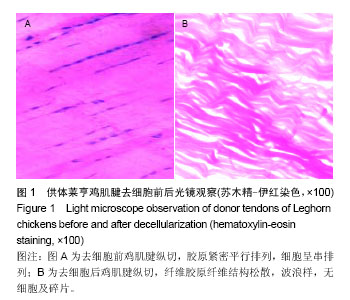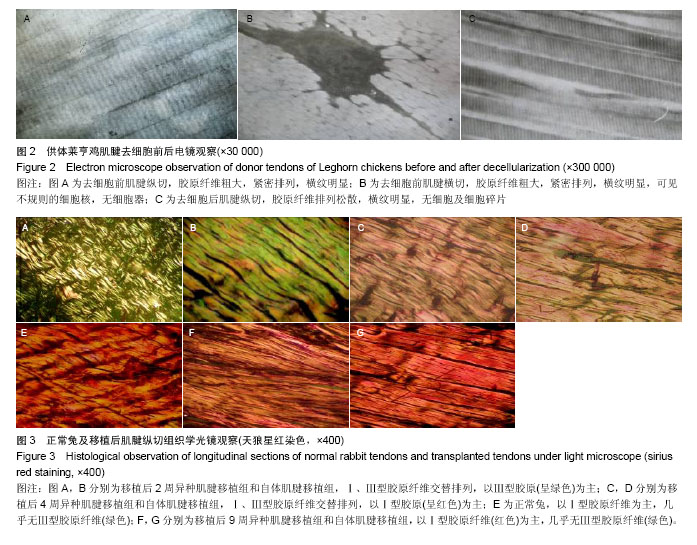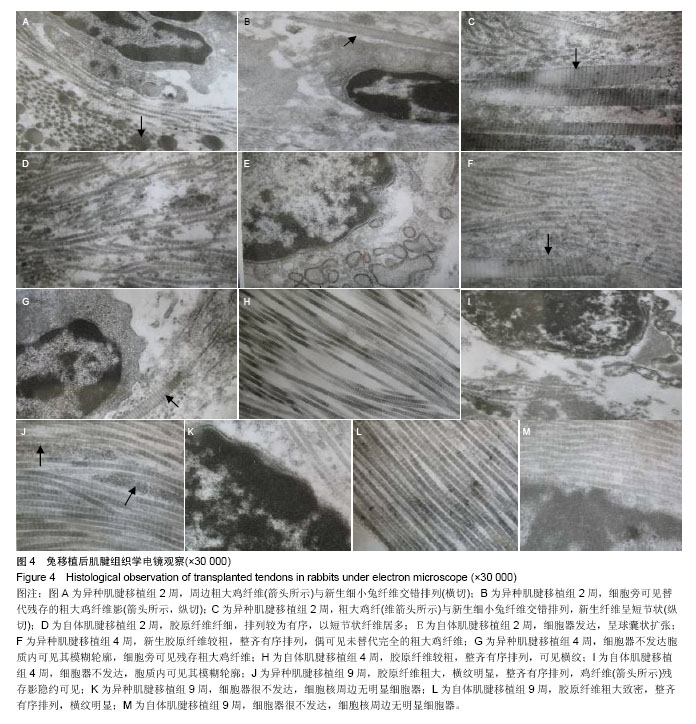中国组织工程研究 ›› 2015, Vol. 19 ›› Issue (8): 1184-1189.doi: 10.3969/j.issn.2095-4344.2015.08.007
• 材料生物相容性 material biocompatibility • 上一篇 下一篇
异种肌腱修复肌腱缺损微观实验:验证可作为临床肌腱修复的生长支架
聂继平,温树正,白志刚
- 内蒙古医科大学第二附属医院手足显微外科,内蒙古自治区呼和浩特市 010030
A micro-experimental study on tendon defect rapair with xenogeneic tendon as a growth scaffold
Nie Ji-ping, Wen Shu-zheng, Bai Zhi-gang
- Department of Hand and Foot Microsurgery, the Second Affiliated Hospital of Inner Mongolia Medical University, Hohhot 010030, Inner Mongolia Autonomous Region, China
摘要:
背景:自体肌腱修复肌腱缺损因可用肌腱有限且形成供区功能障碍,同种异体肌腱同样来源有限,并且价格昂贵,在临床上很难满足其需要。
目的:观察不同时期异种肌腱修复肌腱缺损的微观变化,为异种肌腱作为临床组织工程化肌腱生长支架提供理论依据。
方法:取6月龄的Leghorn鸡屈趾肌腱经化学去细胞处理后作为异种肌腱移植供体,健康成熟日本大耳白兔36只,建立双后肢跟腱中间束2 cm缺损模型,随机分为异种肌腱移植组和自体肌腱移植组,每组18只。肌腱移植缝合用4-0无创伤肌腱缝合线行双“8”字缝合,移植后伸直位管型石膏固定2周,对供体肌腱行去细胞前后大体观察、生物力学测定、组织学光镜及电镜观察,术后2,4,9周每组取6只兔对标本行组织学光镜及电镜检测。
结果与结论:①肌腱经过化学去细胞处理后色泽变白,质地较前柔软,去细胞前可见细胞与胶原纤维交替紧密排列,去细胞后胶原排列相对松散,且无细胞及细胞碎片,去细胞后肌腱的力学强度较术前减弱。②由电镜图片直观看到:随移植时间的延长,移植的粗大鸡肌腱胶原纤维逐渐被再生的兔肌腱胶原纤维最终替代,而新生成的纤细胶原纤维经改造塑形变为粗细相等的较粗大纤维,排列方向逐渐趋于平行,在结构和功能上达到正常肌腱水平。结果表明,去细胞后的最大抗拉力是去细胞前的83.44%,能够满足肌腱移植生物力学的要求。最终肌腱修复是再生胶原纤维形成的结果,异种肌腱经过理化方法处理后可作为临床肌腱修复的生长支架使用。
中图分类号:



.jpg)